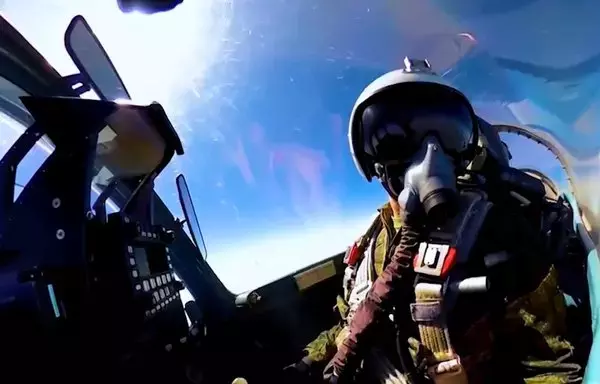The limited avionics capabilities inside Russian Su-35 Flanker-E fighter jets severely hinder their ability to carry out missions assigned to fourth generation aircraft and put them at a major disadvantage compared to Western counterparts, according to numerous reports and analysts.
The Su-35, a modernised version of the Su-27 fighter, is a "4++" generation airplane that uses fifth-generation fighter technology, according to Russian manufacturer United Aircraft Corporation (UAC).
The Su-35 is equipped with the Irbis-E, a Russian multi-mode, hybrid passive electronically scanned array (PESA) radar system.
The system can detect aerial targets at a range of up to 200km -- or up to 350-400km with a narrower field of view -- and is capable of tracking up to 30 targets at a time and guide missiles toward eight of them, without an interruption in airspace surveillance, according to UAC.
![A Russian Sukhoi Su-35 fighter takes off at the Russian military base of Hmeimim, located southeast of Latakia in Hmeimim, Latakia province in Syria, on September 26, 2019. [Maxime Popov/AFP]](/ssc/images/2023/01/23/40414-000_1ko2wz__1_-600_384.webp)
The radar control system can also provide the selective acquisition of moving ground targets and target up to four of them.
It additionally has a synthetic-aperture radar (SAR) mode, which enables it to map landscapes with a resolution of three square metres.
While such capabilities may seem impressive on paper, the Su-35's radar system has unstated limitations, observers have noted.
The Irbis-E's marketed range of 350km range is only in cued-search -- which would most likely require the assistance of airborne early warning and control aircraft or other radar assets, wrote aviation analyst Abhirup Sengupta on Quora.
"More importantly, [the] Su-35's radar has a maximum targeting range of 250km -- even for a B-52-like target," he wrote in 2020, citing aircraft specification documents.
A B-52 bomber makes for a very large target for a radar system, meaning smaller targets would not be picked up by the Su-35 radar system.
Sengupta also pointed to an Irbis-E's flight test video in which it allegedly detected a single target from 268km but was not able to get a track until it was 100km away.
Outdated
The Su-35 is the only major fourth-generation aircraft without an active electronically scanned array (AESA) radar option, a more advanced, sophisticated, second-generation of the original PESA technology.
Compared to PESA radar systems such as the Irbis-E, AESA radars have longer range, an improved ability to detect smaller targets and better resistance to jamming.
That means that other fourth-generation aircraft equipped with AESA radars are likely to be able to detect and engage an Su-35 beyond visual range (BVR) before it can react.
For example, the F-16 Fighting Falcon and its AN/APG-83 AESA have significant advantages over the Su-35.
The AN/APG-83 has a range of 370km, compared to the Irbis-E's 200km in normal volume search.
Even F-16s equipped with the older AN/APG-68 radar have a detection range of 296km.
The Su-35's air-to-ground capabilities also lag behind those of its counterparts.
The Irbis-E's three-metre SAR resolution is comparable to the F-15 Fighting Eagle's APG-70, a system dating back to the 1980s with a reported resolution of 2.6 metres.
For reference, the latest version of the AN/APG-68, the AN/APG-68(V)9, has a SAR resolution of 0.6 metre, which is comparable to pictures delivered by the most modern commercial satellites.
'Defying reality'
Other systems of the Su-35 are also lacking in comparison.
The Su-35's OLS-35 infrared search and track (IRST) fire control system "is the least capable IRST on any modern fighter", according to Sengupta.
A fighter jet can use IRST to detect targets' infrared signature, which is comprised of the heat generated from engines and the frictional heating between the air and the aircraft.
The OLS-35 uses a non-imaging infrared sensor that significantly limits the number of targets it can track, Sengupta noted, adding that the Eurofighter Typhoon's PIRATE IRST can reportedly track up to 500 targets.
Meanwhile, the Su-35's R-73 and R-74 missiles also lack imaging infrared seekers, which limits their capability to shoot without the need to point the nose of the aircraft toward the intended target, Sengupta wrote.
A BVR missile deployed on the Su-35, the R-77, lacks the range and reliability of its Western rivals, international security analyst Sébastien Roblin wrote for Business Insider last August.
"The Su-35 is definitely the most capable fighter in [the] Russian Air Force ... But to say that it's on the same level as today's F-15E, F/A-18E/F, Typhoon or Rafale, much less 'superior' is defying reality," Sengupta wrote, referring to other US-made and European fourth-generation fighters.
"It's marketed as 'world-beating' -- something it doesn't come close to," he said.
"Look beneath the propaganda and they really don't excel anywhere outside maybe air shows."
Secrets no more
The inferiority of the Su-35 became starkly apparent in 2021, when the Egyptian air force tested a French-made Rafale versus the Su-35, Roblin the analyst wrote.
"The attacking Su-35's radar was reportedly rendered useless by defensive jamming from the Rafale's F3R's SPECTRA electronic warfare suite ... The Rafale proceeded to acquire and mock shoot down the Su-35."
The Su-35 has many described shortcomings, and in addition, any secrets it still has will not remain secret for long.
US and British scientists have a downed Su-35 to examine at their leisure in England, thanks to Ukrainian forces who shot it down sometime in 2022, SOFREP.com reported in December.
"Any potential opportunity to examine the radar components or electronic warfare pods on the downed Su-35 would be valuable as, even damaged, such components can confirm or undermine existing intelligence assessments about how they work," Justin Bronk, an air power analyst at the Royal United Services Institute (RUSI) think-tank in Britain, told SOFREP.com.






